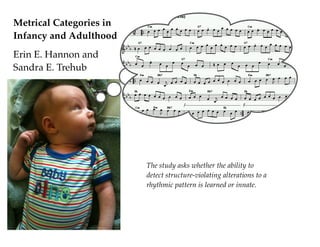Infant rhythm perception
•
1 recomendación•1,266 vistas
A presentation I gave in Psychology of Music class at NYU on a study asking whether the ability to parse complex rhythms is learned or innate.
Denunciar
Compartir
Denunciar
Compartir
Descargar para leer sin conexión

Recomendados
Recomendados
Más contenido relacionado
Similar a Infant rhythm perception
Similar a Infant rhythm perception (20)
Phonemic categorizations of English stops among native speaking/EFL/ESL students

Phonemic categorizations of English stops among native speaking/EFL/ESL students
How Discovering an Educational Musical Instruments Impacts the Development of...

How Discovering an Educational Musical Instruments Impacts the Development of...
Module Six SummaryDiscussion If you’ve had a sociology cl.docx

Module Six SummaryDiscussion If you’ve had a sociology cl.docx
Class 13 emerson_phonetics_fall2014_decipher_therapy_transcript_covert_contrast

Class 13 emerson_phonetics_fall2014_decipher_therapy_transcript_covert_contrast
3.3 Theoretical Perspectives Theorists at one extreme of the issue.docx

3.3 Theoretical Perspectives Theorists at one extreme of the issue.docx
Más de Ethan Hein
Más de Ethan Hein (20)
Sampling as civil disobedience in a copyrighted world

Sampling as civil disobedience in a copyrighted world
Chris Thile, Kendrick Lamar, and the problem of the white rap cover

Chris Thile, Kendrick Lamar, and the problem of the white rap cover
Hip-hop in music education, music education in hip-hop

Hip-hop in music education, music education in hip-hop
The Vocoder, Auto-Tune, Pitch Standardization, and Vocal Virtuosity

The Vocoder, Auto-Tune, Pitch Standardization, and Vocal Virtuosity
The Drum Loop - A constructivist iOS rhythm tutorial system for beginners

The Drum Loop - A constructivist iOS rhythm tutorial system for beginners
Último
https://app.box.com/s/7hlvjxjalkrik7fb082xx3jk7xd7liz3TỔNG ÔN TẬP THI VÀO LỚP 10 MÔN TIẾNG ANH NĂM HỌC 2023 - 2024 CÓ ĐÁP ÁN (NGỮ Â...

TỔNG ÔN TẬP THI VÀO LỚP 10 MÔN TIẾNG ANH NĂM HỌC 2023 - 2024 CÓ ĐÁP ÁN (NGỮ Â...Nguyen Thanh Tu Collection
Último (20)
Beyond_Borders_Understanding_Anime_and_Manga_Fandom_A_Comprehensive_Audience_...

Beyond_Borders_Understanding_Anime_and_Manga_Fandom_A_Comprehensive_Audience_...
Unit 3 Emotional Intelligence and Spiritual Intelligence.pdf

Unit 3 Emotional Intelligence and Spiritual Intelligence.pdf
Jual Obat Aborsi Hongkong ( Asli No.1 ) 085657271886 Obat Penggugur Kandungan...

Jual Obat Aborsi Hongkong ( Asli No.1 ) 085657271886 Obat Penggugur Kandungan...
Food safety_Challenges food safety laboratories_.pdf

Food safety_Challenges food safety laboratories_.pdf
This PowerPoint helps students to consider the concept of infinity.

This PowerPoint helps students to consider the concept of infinity.
TỔNG ÔN TẬP THI VÀO LỚP 10 MÔN TIẾNG ANH NĂM HỌC 2023 - 2024 CÓ ĐÁP ÁN (NGỮ Â...

TỔNG ÔN TẬP THI VÀO LỚP 10 MÔN TIẾNG ANH NĂM HỌC 2023 - 2024 CÓ ĐÁP ÁN (NGỮ Â...
Sensory_Experience_and_Emotional_Resonance_in_Gabriel_Okaras_The_Piano_and_Th...

Sensory_Experience_and_Emotional_Resonance_in_Gabriel_Okaras_The_Piano_and_Th...
Basic Civil Engineering first year Notes- Chapter 4 Building.pptx

Basic Civil Engineering first year Notes- Chapter 4 Building.pptx
Infant rhythm perception
- 1. Metrical Categories in Infancy and Adulthood Erin E. Hannon and Sandra E. Trehub The study asks whether the ability to detect structure-violating alterations to a rhythmic pattern is learned or innate.
- 2. North American music uses simple meters based on groupings of two, three or four beats. When North American musicians conceive of complex meters, we usually think in terms of compounded simple ones. To count in 11/8, we might think "3 + 3 + 3 + 2." Bulgarian and Macedonian adults grow up with music in complex meters, and feel these meters as complete units rather than composites of simple meters. An example of Bulgarian 11/8 (Kopanitsa): http://www.youtube.com/watch?v=Giz3glVPm-I
- 3. Method Fam: familiarization stimulus SP: structure-preserving alteration SV: structure-violating alteration Grey dots show the drum accompaniment to the musical example. Alterations are in the form of added notes, shown by dashed lines. The structure violation in the simple-meter example is an extra eighth note added to the bar of 4/4 time. The structure violation in the complex-meter example is an extra eighth note added to the bar of 7/8 time.
- 4. Findings The top panel shows mean dissimilarity judgments of North American adults. The middle panel shows the same for Bulgarian and Macedonian adults. The bottom panel shows infants' mean looking times. Simple-meter results are on the left, and complex-meter results are on the right. North American adults had no difficulty telling the difference between structure-preserving and structure- violating alterations in simple meters. However, they performed poorly in complex meters. Unsurprisingly, Bulgarian and Macedonian adults performed almost identically on tests with simple and complex meters. Against expectation, however, North American infants performed more like Bulgarian and Macedonian adults than like North American adults.
- 5. Analysis One would naively guess that the ability to parse simple meters is learned early in life, and that we learn more complex metrical schemes by compounding simpler ones. The experiment contradicts this assumption. It appears that North Americans learn a bias toward simple meters — or perhaps we forget how to parse complex meters. Do infants process rhythms differently than adults? Do they just hear strings of beats without hierarchical organization? Probably not. Infants demonstrate the ability to parse other forms of musical organization. For example, they can detect: • subtle changes in duration and tempo • isochronous (steady) versus nonisochronous (unsteady) tone patterns • auditory patterns generalized on the basis of rhythmic structure • unique rhythms on the basis of implied metrical structure
- 6. Discussion Questions Are adult biases in temporal pattern processing learned during musical enculturation? Is there a relationship between our innate ability to parse variations to metrical schemes and our ability to pull words and prosody from the speech stream, even though everyone speaks differently? How do we reorganize our temporal pattern processing tools? How does exposure to music "reprogram" us? More generally, how do we figure out which distinctions meaningful in our culture? If I play a lot of Bulgarian music at home, will Milo be able to groove to 11/8, or does he need to hear it everywhere?
